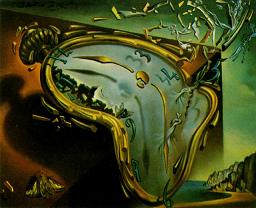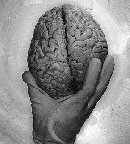Birds build their nests instinctively and many animals “know” how to hunt or find food, but human beings have a very simple set of instincts, such as those for suction and for grabbing. Everything else comes from a process of learning, which is very much an embodied process. As Alliance for Childhood writes in Fool’s Gold: A Critical Look at Computers in Childhood:
In kindergarten, therefore, an emphasis on play and social skills – not premature pressure to master reading and arithmetic – seems most likely to prepare children for later academic success. Researchers have documented how much young children learn intuitively through their bodies, and how this lays a critical foundation for later conscious comprehension of the world. The child’s first experience of geometric relationships and physics, for example, is literally a visceral one.
A study published in Nature by the University of California at Santa Cruz’s researchers demonstrated that while animals learn a new task involving motor learning, new connections begin to form between brain cells almost immediately and they become consolidated in a permanent way in the brain. We all know that when we learn something involving the body, as in driving a bicycle, this knowledge stays with us.
On the evolutionary route, we first see the muscles appearing, and then motor functions, as consequences of living in a certain habitat, and later the associated neuro-physiological functions. The motor activity acts on the brain which in turn acts back on the body allowing a more perfected action. The opposability of the thumb and the erect position of human beings came millions of years before the further development of the brain. It was the work that altered the brain, and not vice versa, as Engels perceived what has been later confirmed by fossils (see Genesi dell’uomo-industria for a longer explanation in Italian).
The hand especially, with its subtle movements, shaped our nervous systems more than any other motor activity of the body. The “technologies” of body movements and of manual labor shaped and developed our brains since primitive times. In mutual feedback, our brains shaped our tools in growing complexity until we arrived at contemporary tools which interact almost exclusively with our minds.
In an experiment, researchers used magnetic scanners to read the brain activity of taxi drivers while they navigated their way through a virtual simulation of London’s streets. Through functional magnetic resonance imaging (fMRI) scanning, they obtained detailed brain images of 20 taxi drivers as they delivered customers to their destinations. Different brain regions were activated as they were planning their routes, spotting familiar landmarks, or thinking about their customers. The BBC article says that:
Their brains even “grow on the job” as they build up detailed information needed to find their way around London’s labyrinth of streets…earlier studies had shown that taxi drivers have a larger hippocampus – a region of the brain that plays an important role in navigation.
Technologies which interact primarily with our minds have an immediate effect on our neurophysiology. Gary Small writes in Ibrain:
Functional MRI studies of young adults ages eighteen to twenty-six years who average fourteen hours a week playing video games have found that computer games depicting violent scenes activate the amygdala. It is perhaps no accident that many autistic individuals, with their small amygdalas and poor eye contact, are almost compulsively drawn to and mesmerized by television, videos, and computer games (p. 73).
The amygdala is an almond-shaped part of the brain located in the temporal region, considered part of the limbic system, where our emotional reactions take place. It modulates our reactions to threats as well. It could be considered a part of the ancient reptile brain, connected to survival, fear, and aggression.
Other experiments demonstrated that only five days of searching with Google by computer-naive subjects were enough to change their neural circuits, in particular, activating the dorsolateral prefrontal cortex. This part of the brain has an important role in our short-term memory and in the integration of sensory and mnemonic information.
Whether we use IT which interact primarily with our minds or mechanical technologies mainly through our bodies, they affect our body/mind even in permanent ways.
In astrological symbolism, the planet Uranus is associated with the hand, with technology, and with the nervous system in its capacity to transmit information. The symbolical–analogical knowledge of Uranus seems to connect all pieces together in a whole. The human nervous system developed from the subtle movements allowed by the human hand, which in turn developed tools and technology.
Technology, even in our hi-tech era, is still something which keeps a connection, though faint, to our hand. The only body movements we do when we use hi-tech tools are by our hands and fingers, through the mouse, the keyboard or a touch screen. Research published in 2009 by the Proceedings of the National Academy of Sciences (PNAS) demonstrated that hand gestures activate the same brain region of language (the inferior frontal and posterior temporal areas), something which any gesticulating Italian can easily agree with.
Ritual gestures (i.e. of the hands) have always been connected with the activation of inner states of the mind. Hinduism’s mudras are a whole discipline of spiritual gestures formed by the hands and fingers. Ancient disciplines such as the tea ceremony or tai-chi which involve many gestures are visible arts as much as an inner development.
The wider neural connections are between the hand and the brain. Handwriting itself, with its subtle and highly personalized movements, can even give a glimpse of our personality through graphology.
What happens when we use technologies which interact almost exclusively with our minds with no or mininal involvement of the body, apart from the obvious cardio-vascular and obesity risks in sitting for a long time in front of a screen?
We’ve seen that even pure IT in terms of searching with Google’s mold our brains, but is the activation of certain areas of the brain the whole story about the potential of human evolution? Can it be that our cognitive capacities are as much in our brains and nervous systems as much as in every organ and cell of our bodies, and perhaps even beyond our bodies? Consciousness itself cannot be inferred by neuroimaging, much less locate wisdom or ethics.
As a culture, we didn’t investigate what happens when we substitute all manual with mental labor, which tends to have direct contact between our minds and the instrument. For instance, if London’s taxi drivers develop a part of the brain according to their navigational efforts through London’s streets, what happens when we rely on GPS for our navigation? As a personal anecdote, one of my acquaintances drove his car from the south to the north of Italy. When I asked him which route he took and whether he passed one town I named or another, he answered that he didn’t notice because he just followed GPS indications. Is there a possibility the same brain areas atrophy which become developed in taxi drivers?
Gli uccelli costruiscono istintivamente il loro nido e molti animali “sanno” come cacciare o trovare cibo, ma gli esseri umani possiedono solo degli istinti molto elementari, come quelli legati all’afferrare e al succhiare. Tutto il resto deriva da un processo di apprendimento, che per la maggior parte avviene attraverso il corpo. Come scrive “Alliance for Childhood” in Fool’s Gold: A Critical Look at Computers in Childhood:
Quindi, sembra che siano il gioco e le doti sociali – e non la pressione prematura a padroneggiare la lettura e l’aritmetica – a preparare i bambini ai futuri successi accademici. I ricercatori hanno dimostrato che i bambini imparano soprattutto intuitivamente, attraverso il corpo, e che questo apprendimento rappresenta una base indispensabile per la successiva comprensione conscia del mondo. La prima esperienza delle relazioni geometriche e fisiche, per esempio, è letteralmente viscerale.
Uno studio pubblicato su “Nature” dai ricercatori della University of California di Santa Cruz ha dimostrato che quando gli animali imparano qualcosa di nuovo a livello motorio, quasi subito tra le cellule cerebrali cominciano a formarsi nuove connessioni che poi si consolidano in modo permanente. Tutti sappiamo che quando impariamo qualcosa che riguarda il corpo, come guidare una bicicletta, questa conoscenza resta con noi.
Lungo il corso dell’evoluzione, vediamo che compaiono prima i muscoli, poi le funzioni motorie (come conseguenza del vivere in un certo habitat), quindi le funzioni neuro-fisiologiche associate.
L’attività motoria ha effetti sul cervello, il quale a sua volta ha effetti sul corpo, permettendo un’azione più rifinita. L’opponibilità del pollice e la posizione eretta degli esseri umani arrivarono milioni di anni prima dello sviluppo del cervello. È stato il lavoro ad alterare il cervello, non il contrario, come Engels intuì e i fossili hanno successivamente confermato (si veda Genesi dell’uomo-industria).
La mano soprattutto, con i suoi sottili movimenti, ha plasmato i nostri sistemi nervosi più di qualsiasi altra attività motoria del corpo. Le “tecnologie” dei movimenti corporei e del lavoro manuale hanno plasmato e sviluppato il nostro cervello, sin dall’epoca primitiva. Tramite un feedback reciproco, il cervello ha plasmato i nostri strumenti rendendoli sempre più complessi, fino a che oggi essi interagiscono quasi esclusivamente con la mente.
In un esperimento, i ricercatori hanno utilizzato la risonanza magnetica funzionale (fMRI), per leggere l’attività cerebrale dei tassisti mentre fingevano di guidare a Londra, in una simulazione virtuale. Attraverso la risonanza magnetica funzionale hanno ottenuto immagini cerebrali dettagliate di 20 tassisti che portavano a destinazione i loro clienti. Mentre programmavano l’itinerario, individuavano punti di riferimento o pensavano ai loro clienti, si attivavano aree diverse del cervello. Come dice l’articolo della BBC:
I loro cervelli «crescevano» letteralmente sul lavoro, man mano che elaboravano informazioni complicate per trovare la strada nel labirinto delle vie londinesi… Studi precedenti avevano dimostrato che i tassisti avevano un ippocampo più grande (una regione cerebrale che svolge un ruolo importante nell’orientamento).
Le tecnologie che interagiscono principalmente con la mente hanno un effetto immediato sulla nostra neurofisiologia. Gary Small scrive in Ibrain:
Studi sulle fMRI di giovani tra i diciotto e i ventisei anni, che passano una media di quattordici ore a settimana ai videogiochi, hanno scoperto che questi ultimi, quando contengono scene violente, attivano l’amigdala. Forse non è un caso che molte persone autistiche, incapaci di mantenere il contatto visivo e dotate di un’amigdala limitata, sono compulsivamente attirate e ipnotizzate dalla televisione e dai videogiochi (p.73).
L’amigdala è una componente del cervello a forma di mandorla, ubicata nella regione temporale, considerata parte del sistema libico, dove hanno luogo le nostre reazioni emotive. Essa modula anche le nostre reazioni alle minacce. Può essere considerata parte dell’antico cervello rettile, collegata a sopravvivenza, paura e aggressività.
Altri esperimenti hanno dimostrato che appena cinque giorni di ricerche su Google, da parte di soggetti poco esperti di computer, erano sufficienti a modificare i loro circuiti neurali, soprattutto attivando la loro corteccia prefrontale dorsolaterale. Questa parte del cervello ha una funzione importante nella nostra memoria a breve termine e nell’integrazione delle informazioni sensorie e mnemoniche.
Sia le tecnologie dell’informazione (IT), che interagiscono principalmente con la nostra mente, sia quelle meccaniche, che invece interagiscono soprattutto con il corpo, influenzano il nostro corpo/mente in modi anche permanenti.
Nel simbolismo astrologico, il pianeta Urano è associato alla mano, alla tecnologia e al sistema nervoso, per la sua caratteristica di trasmettere informazioni. Il sapere simbolico-analogico di Urano sembra in grado di connettere le parti in un tutto. Il sistema nervoso umano si è sviluppato dai movimenti sottili permessi dalla mano e a sua volta ha creato la tecnologia e altri strumenti.
La tecnologia, persino nella nostra era hi-tech, mantiene ancora un legame, seppure debole, con la mano. Gli unici movimenti corporei che facciamo quando usiamo strumenti hi-tech sono quelli delle mani e delle dita, attraverso il mouse, la tastiera o un touch screen. Una ricerca pubblicata nel 2009 da Proceedings of the National Academy of Sciences (PNAS), ha dimostrato che i gesti attivano la stessa area cerebrale del linguaggio (le aree inferiore frontale e posteriore temporale), e questo qualsiasi italiano, con la sua tendenza a gesticolare, può capirlo.
I gesti rituali (come quelli delle mani) sono sempre stati associati all’attivazione di stati mentali. Le mudra dell’induismo costituiscono una scienza completa di gesti spirituali formati da mani e dita. Discipline antiche come quelle della cerimonia del tè o il tai-chi, che comportano numerosi gesti, sono allo stesso tempo arti visibili e conseguimenti interiori.
Le connessioni neurali maggiori sono quelle tra mano e cervello. La scrittura stessa, in quanto composta da movimenti sottili e altamente personali, può darci indicazioni sulla nostra personalità, tramite la grafologia.
Cosa accade quando usiamo tecnologie che interagiscono quasi esclusivamente con la nostra mente, senza alcun coinvolgimento fisico (a parte gli ovvi effetti consistenti in problemi cardiovascolari e obesità, dovuti allo stare troppo seduti davanti a uno schermo)?
Abbiamo visto che persino la pura information technology in termini di ricerche su Google modella il nostro cervello, ma siamo certi che l’evoluzione umana consista soltanto nell’attivare determinate aree cerebrali? Non può essere, invece, che le nostre capacità cognitive risiedano tanto nel nostro cervello e nel nostro sistema nervoso, quanto in ogni organo e cellula del nostro corpo, e forse persino oltre quest’ultimo? La consapevolezza, in quanto tale, non può essere localizzata da uno scanner magnetico, tanto meno possono esserlo l’etica o la saggezza.
La nostra cultura non ha studiato cosa accade quando sostituiamo ogni lavoro manuale con lavoro mentale, che tende a stabilire un contatto diretto tra la mente e lo strumento. Per esempio, se i tassisti di Londra sviluppano una parte del cervello grazie allo sforzo di orientarsi nel traffico londinese, cosa accadrà quando facciamo affidamento sul GPS? Qui posso riferire un aneddoto personale: un mio amico ha fatto un viaggio in macchina, dal sud al nord dell’Italia. Quando gli ho chiesto che strada avesse percorso e se avesse attraversato una certa città, mi ha risposto di non averci fatto caso, perché si era limitato a seguire le indicazioni del GPS. È possibile che la stessa area che si attiva nei tassisti londinesi in questi casi si atrofizzi?








